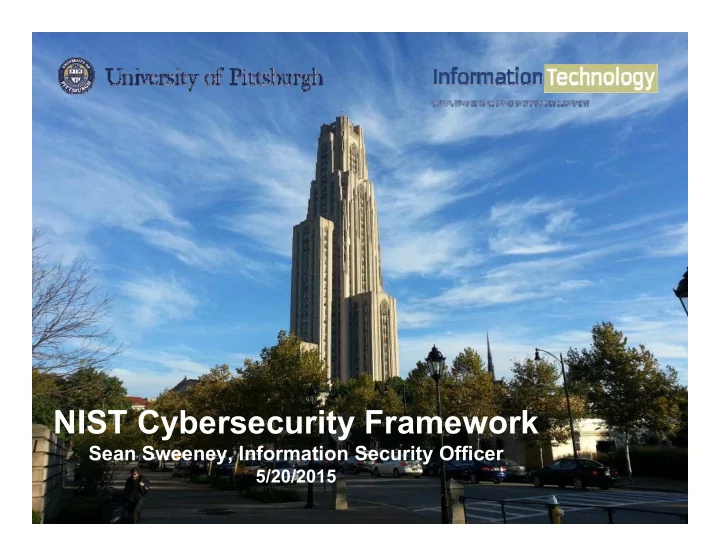

NIST Cybersecurity Framework Sean Sweeney, Information Security Officer 5/20/2015
Overview • The University of Pittsburgh • NIST Cybersecurity Framework • Pitt NIST Cybersecurity Framework Program • Wrap Up • Questions
The University of Pittsburgh
Snapshot: Community Responsibility Centers = 49
Snapshot: Information Security Office • 10 full-time security professionals* – Responsible for: • Enterprise Network Firewalls • Security Monitoring and Alerting • Incident Response • Policy, Risk, and Compliance • Awareness • Security Tools (Managed & Self-service) *Supported by 230 Central IT Professionals
Snapshot: Target-rich Environment • Size and speed of network • Collaborative nature of research—open access • Diverse information-rich environment • Fluid user population • Decentralized IT • BYOD
NIST Cybersecurity Framework
Origin of the NIST CSF • Executive Order 13636, Improving Critical Infrastructure Cybersecurity, Feb. 2013 – Directed NIST to work with stakeholders to develop voluntary framework – based on existing standards, guidelines, and practices – for reducing cyber risks to critical infrastructure
Presidential Policy Directive 21
NIST CSF Overview • Provides standard measurement that organizations can use to measure risk and improve security • Includes senior management understanding of cyber risk • Currently voluntary, but likely the de-facto standard in event of a breach • Common language, not “government speak” • Maps to COBIT, ISO, 800-53, etc.
NIST CSF Design • Core – Five Functions (Identify, Protect, Detect, Respond, Recover) • 22 categories, 98 subcategories • Implementation tiers – Partial, Risk Informed, Repeatable, Adaptive – One size does not fit all • Profiles – Current & Target
NIST CSF Core
Identify • Develop the organizational understanding to manage cybersecurity risk to systems, assets, data, and capabilities. – ID.AM-1: Physical devices and systems within the organization are inventoried – ID.RA-2: Threat and vulnerability information is received from information sharing forums and sources
Protect • Develop and implement the appropriate safeguards to ensure delivery of critical infrastructure services. – PR.AC-1: Identities and credentials are managed for authorized devices and users – PR.DS-1: Data-at-rest is protected
Detect • Develop and implement the appropriate activities to identify the occurrence of cybersecurity event. – DE.AE-1: A baseline of network operations and expected data flows for users and systems is established and managed – DE.CM-3: Personnel activity is monitored to detect potential cybersecurity events
Respond • Develop and implement the appropriate activities to take action regarding a detected cybersecurity event. – RS.RP-1: Response plan is executed during or after an event – RS.MI-1: Incidents are contained
Recover • Develop and implement the appropriate activities to maintain plans for resilience and to restore any capabilities or services that were impaired due to a cybersecurity event. – RC.RP-1: Recovery plan is executed during or after an event – RC.CO-1: Public relations are managed
Tier 1 Partial • Risk Management Process – Ad hoc • Integrated Risk Management Program – Limited awareness of risk. Managed case by case basis. • External Participation – No processes in place to collaborate.
Tier 2 Risk Informed • Risk Management Process – Established by management, but not policy. • Integrated Risk Management Program – Awareness of risk. Managed well. No organization wide approach. • External Participation – No formal processes for interaction and sharing.
Tier 3 Repeatable • Risk Management Process – Expressed by policy. Practices updated regularly. • Integrated Risk Management Program – Organization wide approach to manage cyber risk. • External Participation – Receives information from partners for collaboration
Tier 4 Adaptive • Risk Management Process – Continuous improvement incorporating advanced technologies and practices. • Integrated Risk Management Program – Cyber risk management is part of culture • External Participation – Actively shares information with partners
Note About Tiers • Tiers do not represent maturity levels. • Progression to higher Tiers is encouraged when such a change would reduce cybersecurity risk and be cost effective. • Successful implementation of the Framework is based upon achievement of the outcomes described in the organization’s Target Profile(s) and not upon Tier determination.
Profiles • Alignment of the functions, categories, and subcategories with the business requirements, risk tolerance, and resources of the organization. • Current and Target – Current outcomes vs those needed to achieve goals. • Comparison of Profiles – Gap mitigation prioritized and roadmap created – Allows organization to prioritize resources • “Living” document
NIST CSF Decision Flows
Pitt NIST CSF Program
Steps 1. Prioritize and Scope 2. Orient, Create Current Profile 3. Conduct Risk Assessment 4. Create Target Profile 5. Determine, Analyze, and Prioritize Gaps 6. Implement Plan of Action
Year 1 (July 1, 2014 – June 30, 2015) • Focused on enterprise network and systems managed by central IT. • Included central IT stakeholders in preparing profiles • Presented profiles and roadmap to executive management • Internal Audit review
Year 2 (July 1, 2015 – June 30, 2016) • Expand scope of the system and assets by using framework on two key non-central units. • Adapt framework for departmental/school use. • Train key personnel to perform current state assessment. • Information Security to create target profile, gap analysis, and remediation plan with input from departments/schools.
Wrap Up
Future of NIST CSF • Roadmap published with CSF – Identified key areas of development, alignment, and collaboration. • Critical Infrastructure Cyber Community Voluntary Program – Focuses on Use, Outreach, and Feedback – Onsite or self-guided Cyber Resilience Review • Many critical sectors still determining how to apply framework
Cross walking the NIST CSF
Thoughts on NIST CSF • Allows communication of cyber risk up and across • Not overly prescriptive, but not vague • Not purely an IT controls exercise • Able to apply to unique enterprise without modification • Allows for prioritization of risk and associated resources • Future unclear
Questions?
Recommend
More recommend